Governor of Bourbon from 1715 to 1718, in 1716 Henri de Justamond authorised hunting between Saint-Leu and la Rivière Saint-Etienne, thus opening out settlement on the south of the island. Three years later, on 5th March 1719 , Antoine Desforges-Boucher (v.1681-1725) was granted the concession of Le Gol, between the ravine of the same name and that of Ravine des Cafres to the west: it was the first concession granted on the territory of what is now the town council of Saint-Louis. On 18th July 1722, the plateau lying between the Ravine du Gol to the west and the Bras du Milieu to the east, also known as the Ravine du Mouchoir Gris, was granted to his brother-in-law Paul Sicre de Fontbrune, who arrived on Bourbon island in the same year.
Settling first in Saint-Paul, then posted to Sainte-Suzanne, he could not develop his concession in Saint-Louis. On 19th March 1725, it was handed over to the Company then, six days later, transferred to Antoine Desforges-Boucher, who thus became owner of all the land lying between Ravine des Cafres and Ravine du Mouchoir Gris, making him one of the colony’s biggest landowners.
Desforges-Boucher died on 1st December 1725, before being able to apply to his land in Saint-Louis the measures regarding coffee growing he wished to impose on the settlers. On 4th December of that year, his heirs drew up an inventory of the property they possessed on the island. The inventory of the estate of ‘Le Gaule’ was succinct in character. The land, with sections that had been cleared and planted with coffee, was estimated at 15,000 pounds. The estate had 30 slaves, estimated at 28,805 pounds. The livestock, consisting of 100 heads of cattle, 140 sheep, lambs and goats and 47 pigs, was estimated at 1,713 pounds, giving a total of 45,518 pounds, the equivalent of approximately €700,000 in today’s money.
Seven years after this inventory, on 16th August 1732, the property of Desforges-Boucher’s heirs was shared out. Le Gol was divided up into two estates: the first stretching between the Ravine du Maniron to the west and “the first arm of the lake of l’étang du Golle” to the east; the second stretched from “the first arm of the lake of Le Gol to the west as far as the ravine of l’étang du Golle to the east”. If we understand “the first arm of Le Gol” as being the current Ravine du Gol and the ravine of L’étang du Gol as being the current Ravine du Mouchoir Gris, this 1732 division resulted in the two distinct estates of Le Gol and Maison Rouge. They remained in joint possession: among the heirs were Antoine-Marie and Jacques, mentioned above.
In 1735, the general census drawn up at the request of Bertrand François Mahé de La Bourdonnais, shortly after he arrived on the Mascarene islands, shows that the Desforges-Boucher heirs possessed 24 slaves in Saint-Louis: 15 men and 9 women. 20,000 coffee plants were in production. The estate also produced 500 quintals of wheat (25 t.), 200 of corn (10.16 t.) and 500 of beans (25.4 t.).
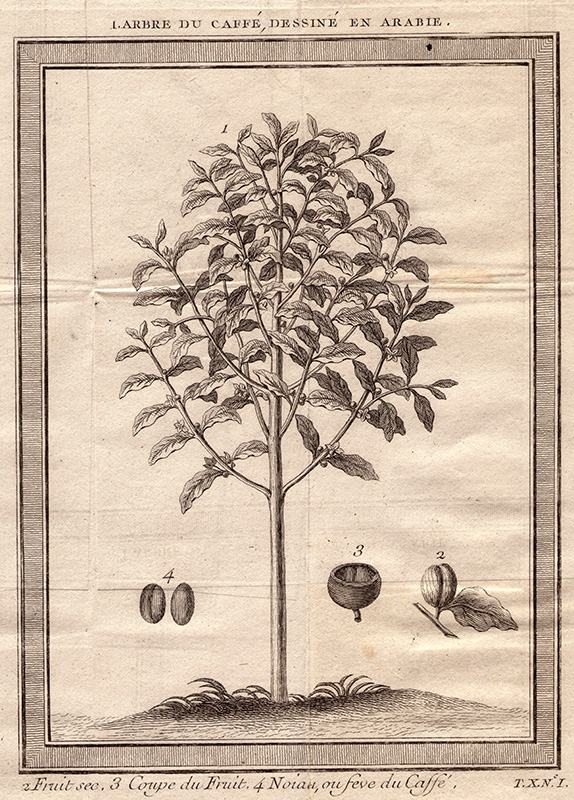
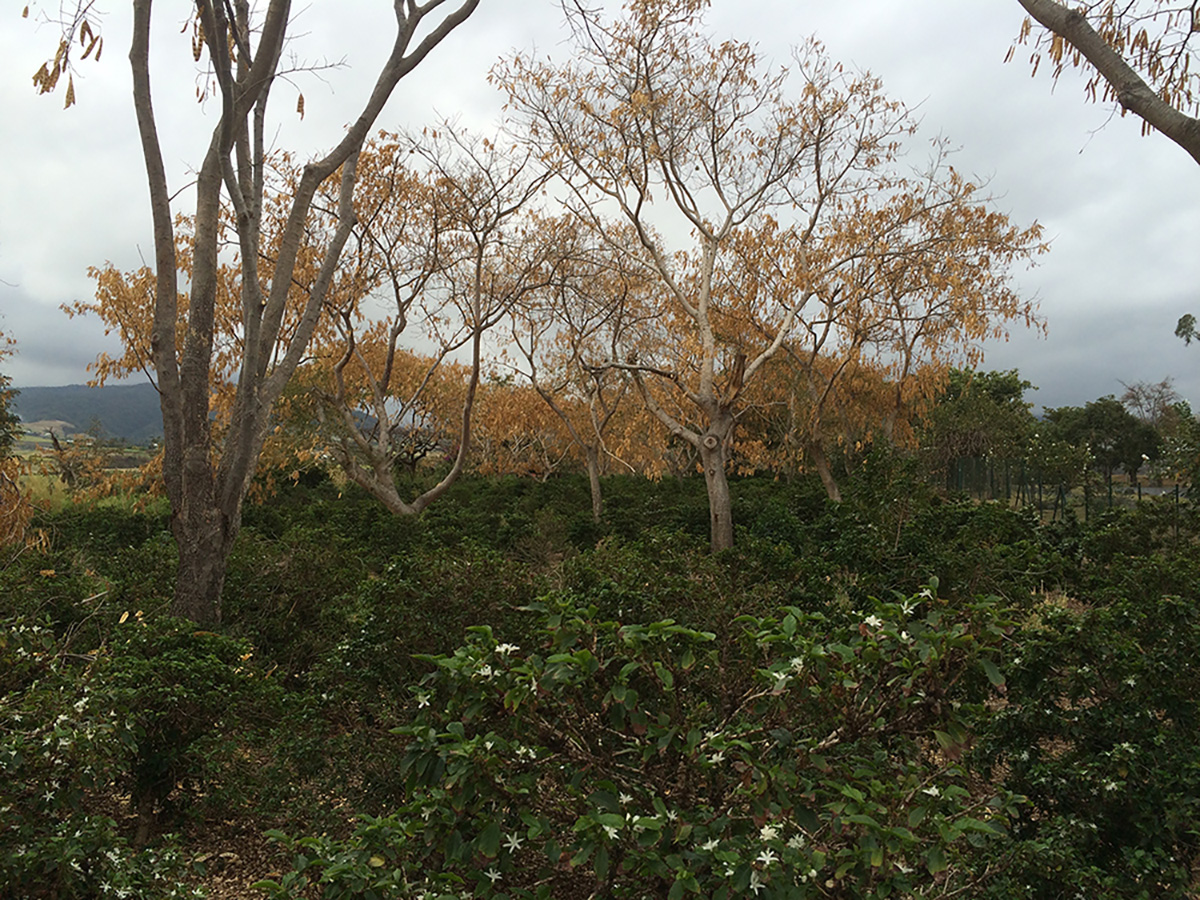
After studying in mainland France, the Desforges-Boucher brothers came back to the Mascarene islands: Antoine-Marie in 1736 and Jacques in 1749. The former, a military engineer posted to Bourbon island, then to île de France, followed a brilliant career, finally becoming Governor General of the Mascarene islands in 1767. He then retired to Saint-Louis, before leaving the colony for good to settle in Lorient in 1783.
In 1749, Jacques Desforges-Boucher, former officer on French East India Company ships, settled in Saint-Louis, where, on 17th October 1750, he married Marie Elisabeth Le Lubois (1729-1808) . According to his prenuptial contract, Jacques Desforges-Boucher added to his name the particle of ‘Maison Rouge’, at the origin of the name given to estate. The couple had ten children, the first nine born in Saint-Louis between 1753 and 1766. In view of the responsibilities held by his elder brother, Jacques took charge of the vast family estate of Le Gol and Maison Rouge.
The 1740-1750 censuses provide us with information on the crops grown on the land belonging to the Desforges-Boucher family. In 1744, the estate of Le Gol was managed by three ‘economists’ (stewards). There were 146 slaves working the land and 20,000 coffee bushes were planted, producing an annual yield of 209 quintals of coffee (10.6 t.). Do these figures refer solely to Le Gol or do they also include the land of Maison Rouge?
Eight years later, in 1752, another census enables us to estimate the fortune of Jacques Desforges-Boucher, the property of the two brothers being assessed separately. The latter possessed 99 slaves in Saint-Louis, 76 of whom were adults, probably living on the estate of Maison Rouge. The area of the estate devoted to agriculture covered 651 acres (222.56 ha.), with 10,000 bushes producing coffee. However, there was also production of corn (200 quintals, 10.16 t.), wheat (100 quintals, 5.080 t.) and rice (100 quintals, 5.080 t.), as well as 250 heads of cattle, 120 sheep and 100 pigs.
These figures can be compared to the census of the property belonging to his elder brother in Le Gol, property placed under the authority of a steward. On the estate, Antoine Marie Desforges-Boucher had 162 slaves, 129 of whom were adults. The livestock on the estate included 180 heads heads of cattle, 150 sheep and 180 pigs. The wheat harvest totalled 180 quintals (9.14 t.), with 600 quintals of corn (30.481 t.) and 60 quintals of rice (3 t.). Finally, 40,000 coffee plants were in production. A total of 836 acres was given over to agriculture (285.807 ha.).
In the mid 18th century, the Desforges-Boucher brothers were justifiably considered to be the biggest landowners in Saint-Louis. The house, the famous ‘Château du Gol’ , constructed close to the lake a few years previously (1747) by Antoine Marie, bears witness to this extraordinary success.
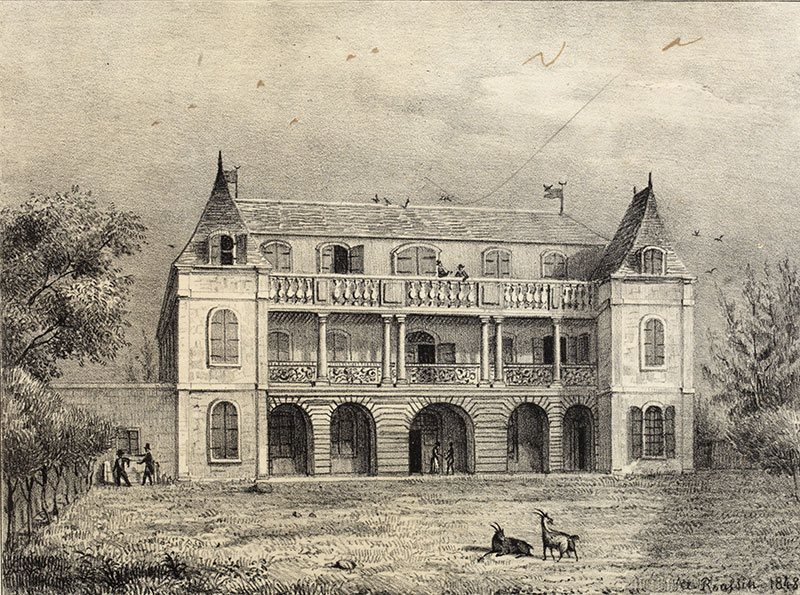
According to Jean Richard , “the family life (of Jacques Desforges-Boucher) during the whole period he spent on Bourbon island hardly deserves commentary: it had its ups and downs, connected to changes in climate. In his letters to his brother, Antoine Marie only refers to material and financial questions, crops, livestock and equipment to be ordered from the warehouses of the Company”. In August 1767, Antoine Marie settled in Le Gol for good, leading his brother Jacques to leave for Lorient, where he settled in July of the same year.
On 5th February 1767, according to a letter from Antoine Desforges-Boucher, Jacques sold his estate of Maison Rouge to a certain Duclos. In another letter, dated 25th August 1768, Antoine Marie declares: “Mr and Mrs Boucher (Jacques and his wife) were right to sell up and go to live in Europe; they were dying of boredom in their mountains.” However, Duclos did not pay his debt and in 1773 Jacques Desforges-Boucher once more became the owner of Maison Rouge. Management of the property was entrusted to Taillepied, qualified by Antoine-Marie , as being “the best and the most intelligent farmer on the two islands”. After his death in 1775, the job was taken over by a white manager.
Finally, in 1779, Maison Rouge was rented out for a period of two years (for 8,000 pounds per year) to Nicolas Le Meur, a former naval surgeon who had settled on the island in 1771. Le Meur left Bourbon in 1780 and Antoine Marie entrusted Maison Rouge to Etienne de Saint-Martin , first cousin of Antoine Marie and Jacques, “until the end of the war of independence in the United States, in 1783”.
In 1783, Antoine Marie Desforges-Boucher also left Bourbon for good to settle in Lorient. In December 1784, he sold his estate of Le Gol to Antoine François Pascalis and Jean-Baptiste de Lestrac. Thus, at the end of the Ancien Régime, Maison Rouge, the last estate owned by the Desforges-Boucher in Saint-Louis, became an estate totally independent of the estate of Le Gol.
On 17th August 1786, Jacques Desforges-Boucber died in Lorient at the age of 65. His heirs had an inventory of their father’s estate drawn up in Bourbon on 7th October 1789, , in the presence of Joseph Jacques François aka “Joson” Desforges-Boucher (1764-around 1838), a member of the family representing his sisters. The estimate was made by Antoine François Pascalis, the king’s warehouse manager at Etang-Salé and Grimaud, former captain of the Bourbon volunteer corps and tenant of the estate. The inventory reads:
A main house of planks with ground floor rooms and top floor, with a wooden shingle roof, the roof, wall-plates, doors and windows in poor condition; a timber storehouse with a wooden shingle roof, boarded top and bottom, in very poor condition; another storeroom in timber, boarded and with a roof of leaves, again in poor condition and in no fit state for storing cereals; a small log hut used as a storehouse and falling into disrepair; a chicken coop of planks, with a roof of leaves and huts for the Blacks in extremely poor condition.
115 slaves lived on the estate. Three plots were planted with corn, one with rice and there was also “a young coffee plantation of three or four years and promising a good yield.” But the Desforges-Boucher heirs owed Grimaud 821 pounds for working the land on the estate. ‘Joson’ Desforges-Boucher stayed on Bourbon, in order to deal with the inheritance, but more probably because of the disturbances due to the French Revolution. Was he living on the estate of Maison Rouge at the time? On 8th July 1795, he married Geneviève Euphrasie Eléonore Fréon in Sainte-Suzanne, whom he divorced in 1814. Apparently, Joseph Desforges-Boucher left the island for good in 1805.
During the years 1800-1810, the censuses of the estates in the district of Saint-Louis are currently the only the sources of information available on the history of the estate in the early 19th century. Three of these censuses have been found, for the years 1805, 1808 and 1811.
| Years | Slaves | Crops | Area farmed (ha.) | Yield (t.) |
|
1805 |
103 |
Wheat | 125 | 12,7 |
| Corn | 5 | 77,219 | ||
| Cotton | 2,4 | 1,27 | ||
| Coffee | 1 | 1,16 | ||
|
1807 |
109 |
Wheat | 125 | 12,192 |
| Corn | 5 | 30,481 | ||
| Cotton | 2,4 | 1 | ||
| Coffee | 1 | 1,422 | ||
|
1811 |
117 |
Wheat | 0,5 | Non id. |
| Corn | 1 | Non id. | ||
| Cotton | Non id. | |||
| Coffee | 3 | Non id. |
These figures demonstrate the importance of food crops grown in the south of Bourbon island in the 18th century. These represented a large proportion of the income of the Desforges-Bouchers at the start of the 19th century. Coffee as a crop decreased in importance. In 1811, possibly as a result of the poor climate conditions in the colony during this period, the estate appears to have been abandoned.
In 1814, just before the island was handed over, the census of the Desforges-Boucher heirs mentions Richard Nairac (1763-1831), at that time aged 52, as being their representative on Bourbon. Nairac and his wife Marianne Barbe de Lanux (1763- 1828) had been living in Saint-Louis since 1788.
Progressively, Nairac bought up their shares, as is witnessed by the sale on 11th September 1827 by Sophie Doizon, , widow of Delahutte Férat and Virginie Violette, widow of Landes de Saint-Palois and wife of Couchoux of “their interests, shares and rights in an estate called Maison Rouge and its outhouses situated in Saint-Louis”. It appears impossible to determine precisely the dates of the other sales to Neirac by the heirs of Jacques François Desforges-Boucher at the start of the 19th century. In the early 1830s, he was the only owner of Maison Rouge.
On 21st July 1831, Nairac died in Saint-Louis, leaving five heirs: Anne Marie Lucie Nairac (1769-1868), widow of Hyacinthe Murat; Auguste Baptistine Edite Nairac (1787-?) wife of Nicolas Seuriot; Antoinette Sophie Henriette Nairac (1791-?), wife of Auguste Baudry; Paul Émile Henri Nairac (1796-1858); Suzanne Marie Anne Nairac (1797), wife of Jean Sénac.
An inventory was drawn up on 5th August 1831 at Maison Rouge, on an estate at Ravine Blanche and a house on the Rue Royale in Saint-Pierre. The inventory of the property at Maison Rouge indicates a very rustic estate, compared to the other properties.
One year later, on 20th August 1832, the Nairac heirs shared out their father’s estate. Maison Rouge was divided up into four parallel strips of land, from the meeting point of the two ravines up to the mountain peaks. They were attributed respectively to Anne Marie Lucie Murat, Paul Émile Nairac, Henriette Baudry and Suzanne Sénac. During the 1830s, Anne Marie Lucie Murat reassembled the whole estate to her profit, buying up the shares belonging to her brother and her sisters. These sales of land took place in the context of the ‘sugar-cane development’ in the colony during the first 40 years of the 19th century.
Like everywhere else on the island, the territory of the district of Saint-Louis progressively underwent a change of character: fields of sugarcane replaced coffee, cotton and above all the cereals that had been the source of wealth in the district. Aware of the economic changes taking place, Lucie Murat modified the layout of the fields of Maison Rouge, then constructed a sugar processing plant in 1834-35, thanks to a special financial operation.
On 26th November 1834, Alphonse Lefebvre, a stockbroker in Saint-Paul, and Virginie Pillet de Troissy, a primary school teacher, set up a company with the aim of creating a sugar-processing plant at Maison Rouge, just below the main house. In exchange, Lucie Murat would deliver her sugar-cane production. Thus the industrial investment was not made by the owner of Maison Rouge, but by financial backers. Payment of death duties on Nairac’s estate and purchase of her brother’s and sisters’ shares in Maison Rouge took their toll on Lucie Murat’s finances. On 7th March 1835, Alphonse Lefebvre and Virginie de Troissy promised to sell to Lucie Murat the sugar factory they had constructed at Maison Rouge, in exchange for 140 tonnes of sugar. Virginie de Troissy sold her shares on 30th June 1837 and the heirs of Lefebvre did the same on 27th May 1840. The purchase deed contains the only detailed description we have of the sugar factory of Maison Rouge in the 19th century. It consisted of four buildings: “a stone building containing a four horse-power steam engine; a wooden building used as a sugar factory, containing a ‘battery’ (boiler room) setup with six cast-iron boilers (‘Adrienne battery’), two sugar-tables, 10 sugar ladles, ten skimmers, a two-comportment copper-lined wooden tub; a wooden building used for producing syrup, containing a ‘battery’ equipped with a single cast-iron boiler and a sugar-table; a two-storey building used for purifying and containing 42 sugar moulds (…) all of the buildings have wooden shingle roofs.” These industrial buildings were located on the current site of the fertiliser storehouse, constructed in the early 1950s.
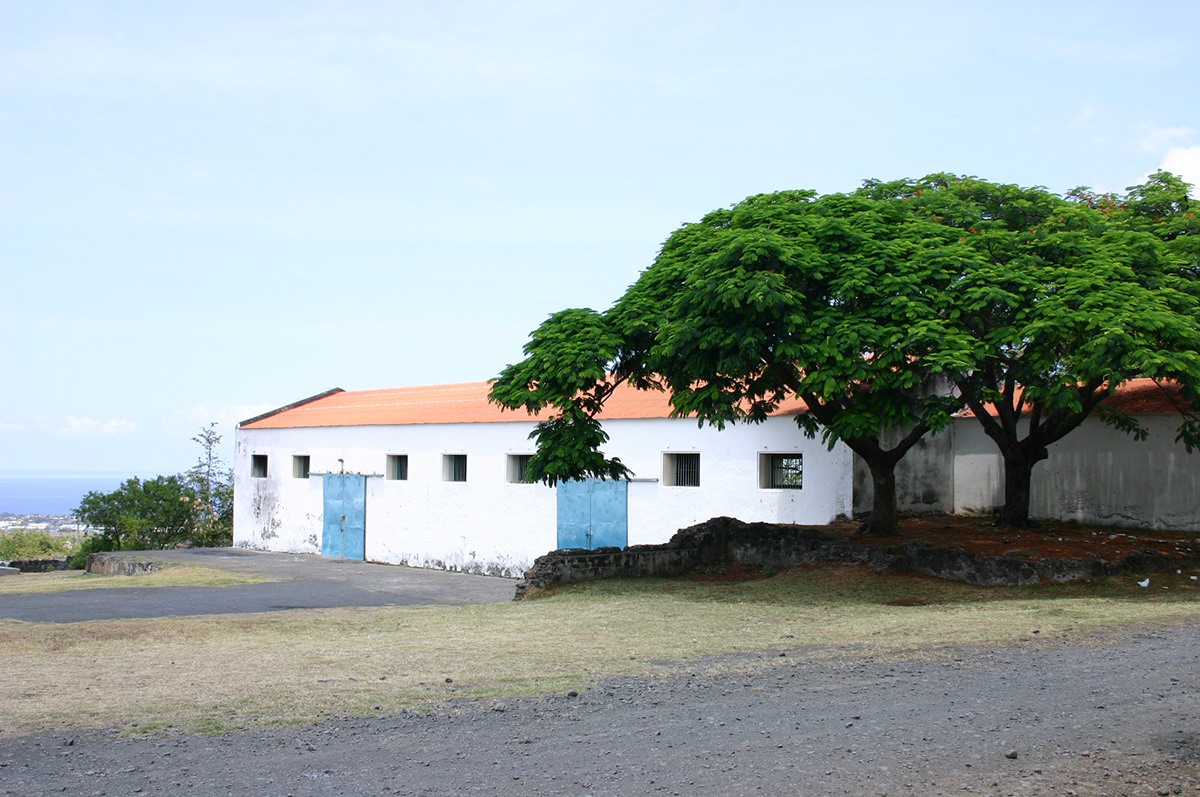
The annual censuses of the owners during the first half of the 19th century contain no information on the sugar harvested at Maison Rouge. Only the slaves are listed, and at times the livestock. Thus, between 1835 and 1848, the number of slaves increased from 118 to 217, an increase of 89 individuals. The majority of them were Creole, that is to say born on the island, Noirs de pioche (Black labourers). However, there were also Noirs à talents (specialised Black slaves), for example in 1842 Auguste, aged 26, Créole, head pump operator and David, aged 33, Creole, head sugar worker.
Very probably, the mansion of Maison Rouge was constructed by the Murat family, replacing the one constructed by the Desforges-Boucher. The screen façade, an architectural feature first applied to Creole architecture in the 1830s, with its arched veranda and fanlight windows, shows the influence of neoclassical architecture that became popular on Bourbon island in the first half of the 19th century.
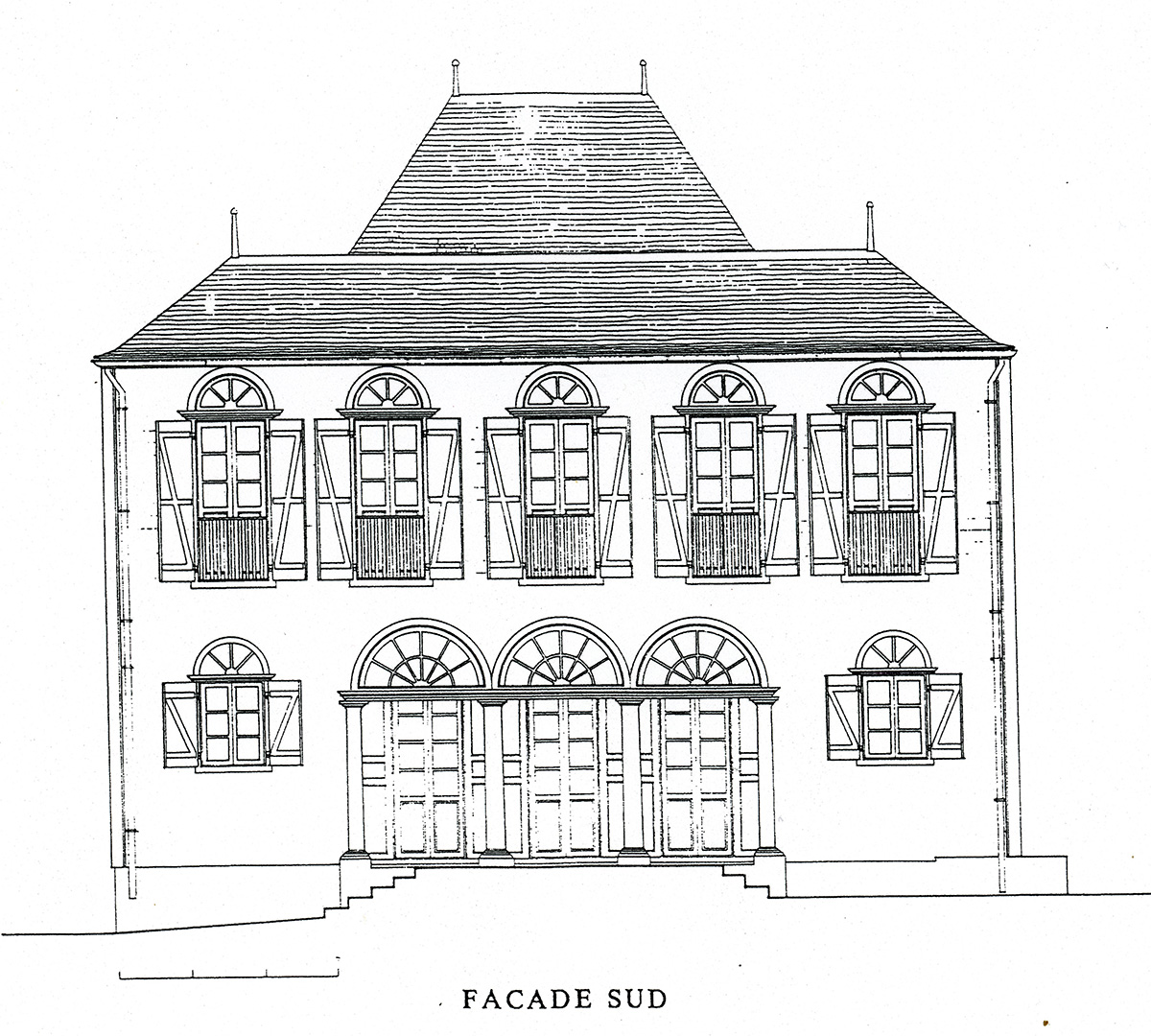
From 1850 to 1863, the sugar economy reached its peak. As from 1863, a serious economic crisis affected the colony. Like everyone else, the Murat family underwent the negative effects of the slump. On 1st March 1864, Lucie Murat and her son Hyacinthe Murat mortgaged the estate to Jean-Baptiste Pruche-Aubry, a negotiator in St Denis, for the sum of 190,000 francs. On 24th January 1865, a new mortgage was added, this time to the benefit of the Crédit Foncier Colonial, a loan structure set up on the island. .
Following an application made by the Crédit Foncier Colonial, the Murat family, unable to pay their instalments, were expropriated. The expropriation took place on 12th May in 1867, to the benefit of Dominique Edevin Hoarau the elder, (1815-1885), who bought the estate for the price of 560,000 francs.
The description in the notarial deed is succinct. 279 indentured labourers, including “194 men aged over 16”, living in the ‘camp’ (compound) of Maison Rouge, their contracts having been transferred to Hoarau. Were included in the purchase “a two-storey mansion, various large and small outhouses, kitchens, various storehouses, cowsheds, a dovecote, a shed, a cart workshop, a building used as a smithy, stables, building with installations for sugar production, a building constructed for the sugar press, a syrup tank, two sheds for bagasse, houses and huts for servants and indentured labourers.” The sugar-plant equipment consisted of “a six horse-power machine by Desronne et Cail, used to power the turbines, a six horse-power machine by Fawcett used to power the sugar press and low temperatures, a 40 horse-power generator, a Gimard battery, consisting of seven copper boilers, 14 wooden tables, five turbines, five low-temperature machines, two purifiers for the scum.” The livestock consisted of 42 mules, 10 pigs and 20 sheep. The transport equipment consisted of 16 sugar-cane carts, 5 carts for transporting straw and 3 tumbrels. Mention of a corn-mill and a coffee ventilator indicate the existence of food crops being grown, as well as a small amount of coffee remaining.
Born in Saint-Louis on 3rd January 1815, Dominique Edevin Hoarau was the son of Vilfride Elécy Hoarau (1793-1837), landowner, and Louise Lucine Mondon (1802-1841). His father was the grandson of a former command major of the National Guard of Saint-Louis in 1794, and his mother’s family belonged to the ‘petty bourgeoisie’ of the town’s shopkeepers. On 24th January 1844 in Saint-Louis, he married Marie-Anne Zénithe Hibon (1783-1858), widow of Henri Michel Lossandière (1785-1842) . The Hoarau-Hibon spouses had no children.
This first marriage opened the doors to him of the ‘sugar aristocracy’ in the area. The Hibon family owned several large estates in Saint-Leu and Les Avirons, as did the Lossandière family. In 1842, when her first husband died, Marie Anne Hibon inherited several plots of land in Saint-Leu. Upon the death of her father Jean Zénon Hibon in 1845, she became a rich heiress. Consequently, in 1867 Dominique Edevin Hoarau bought Maison Rouge thanks to the fortune he inherited from his wife, who died in Saint-Louis on 18th January 1858.
Six years later, on 26th April 1864, Dominique Edevin Hoarau married again, to Anatholie Leperlier (1839-1906), known as ‘Marie Ernestine’, daughter of Gabriel Duclesmur Leperlier (1800-1867) and Marie Sabine Hoarau (1802-1843). They had six children: Dominique Edevin junior, Marie Lucina Ernestine who married Michel Brun, Berthe who married Victor Fourcade , Louis Ely, Marie Mathilde et Ernestina épouse d’Henri Gonthtier.
Owner of Maison Rouge from 1867 to 1885, Dominique Edevin Hoarau proceeded to purchase several pieces of land located nearby: a plot at l’Éperon (approximately 30 ha), acquired in 1870 from Anne-Marie Lucie Nairac, widow of Murat and land at Roches Maigres (eleven plots, 119 hectares), purchased on 10th August 1871 from Amédée Patu de Rosemont .
To these purchases were added several acquisitions in the same area during the 1880s. Around 1870-1880, the land acquired on the southern shores of the river of La Ravine du Mouchoir Gris led to the construction of a cable car between the two banks of this river, making it possible to transport to the sugar factory of Maison Rouge the sugar-cane planted on the slopes above.
Maison Rouge (357 ha), l’Eperon (30 hectares) and Roches Maigres (119 hectares) formed an estate of over 500 hectares in Saint-Louis. The land owned by the Hoarau family was not limited to the land of Maison Rouge and Roches Maigres. There were also several other plots at Le Gol and Étang-Salé. In the early 1870s, Hoarau became one of the notables of the south of the island and his ambition to acquire land, though more modest perhaps, can be compared to that of the K/véguen or Choppy families during the same period.
Dominique Edevin Hoarau died at Maison Rouge on 21st August 1885. His estate, held in joint possession between 1885 and 1891, was administered by Dominique Edevin Hoarau the younger. In 1891, the latter bought Maison Rouge and its outhouses. Family rumour has it that it was Fernand Inard who lent him the 500,000 francs necessary. Maison Rouge covered an area of 357 hectares, which included 23 ha of forest, 3 ha for the factory and its outhouses, 24 ha of pastureland, the remainder being planted with coffee, sugar cane and cereals. The sugar plant is still in activity today.
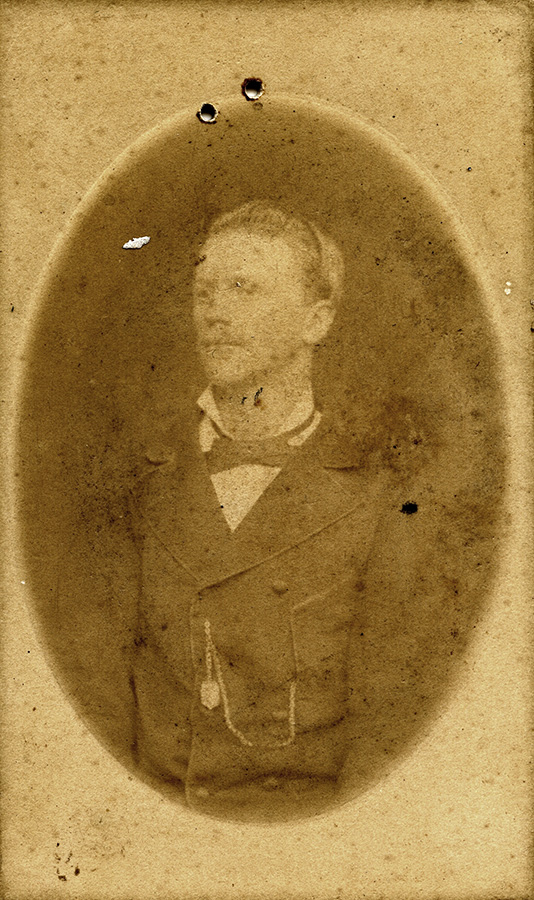

The Hoarau Family was probably responsible for the layout of the buildings around the main mansion, although this is not certain. On west side of the mansion is a construction that was used as a dining room, with storehouses and a kitchen added in the backyard. On the east side is a secondary construction with an independent entrance, making it possible to house other members of the family.
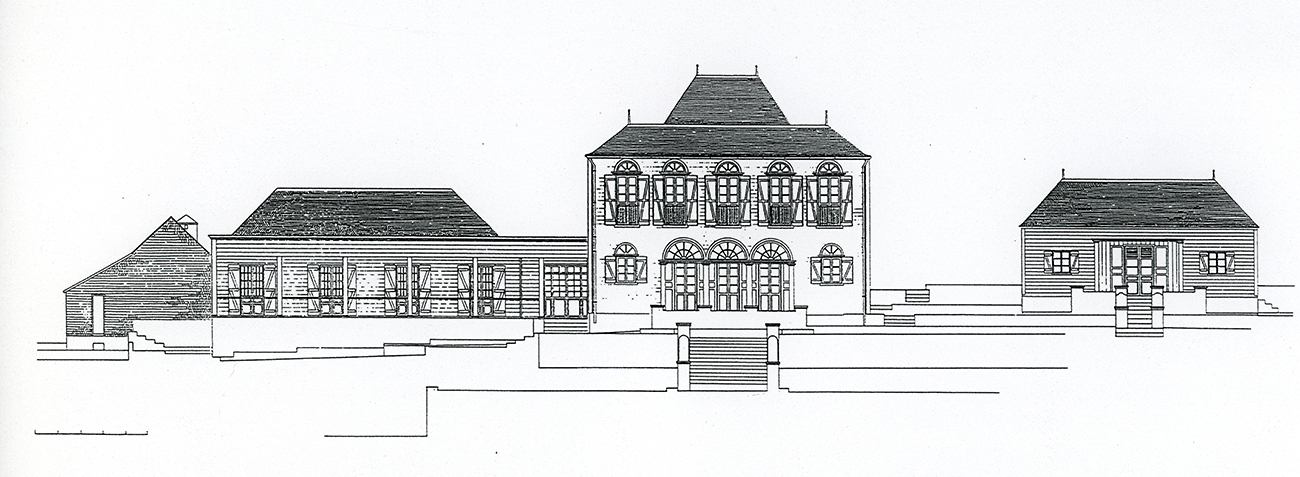
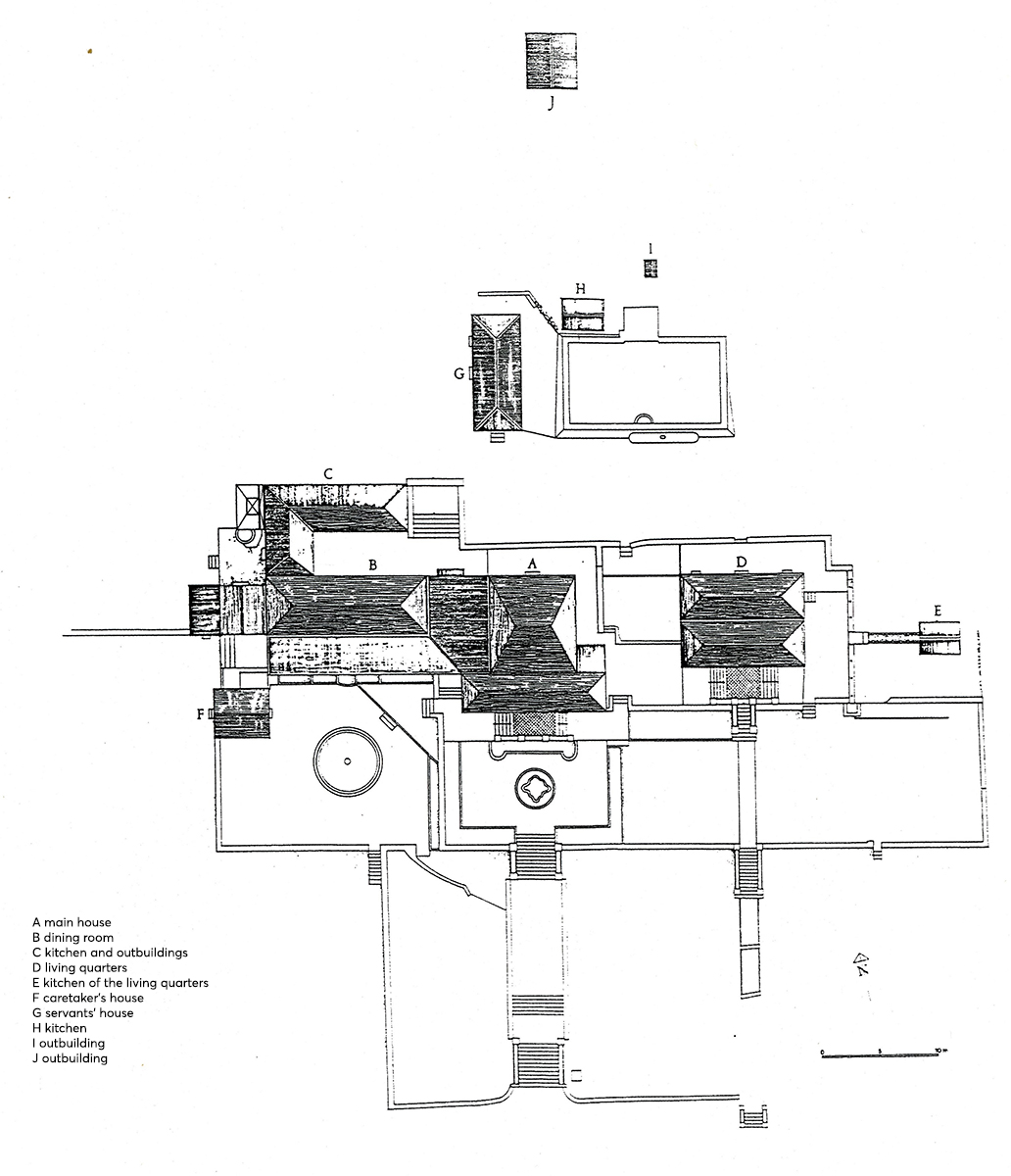
Five years later, on 5th April 1896, the estate was sold to Charles Martin, resident in Saint-Denis. The amount of the transaction, 150,000 francs, leads us to suppose that the sale was carried out to cover the various mortgages related to the estate. One year later, Martin still had not paid the 150,000 francs of the sale and on 15th March 1897, the estate was transferred to Fernand Albert Inard. The sugar factory probably ceased functioning a short time later, following which the sugar cane from Maison Rouge was transported to the processing plant of Le Gol or the one of La Rivière or La Chapelle in Saint-Louis .
From 1897 to 1971, Maison Rouge was owned by Fernand Inard, then by his daughter Fernande, wife of Léonus Bénard, planter, industrialist and important politician during the first half of the 20th century in Reunion. In the collective memory, these two names, Inard and Bénard are the ones pronounced the most often when referring to the history of Maison Rouge.
Born on 9th September 1860, Fernand Albert Inard (1860-1931) was the great-grandson of Mathurin Inard (1761-1828), manager of Maison Rouge in 1805 for the Desforges-Boucher family.
His father, Ernest Inard (1833-1875), belonged to the petty bourgeoisie of Saint-Pierre, where he worked as a negotiating clerk in 1867, then secretary for the police department at the time of his death. His mother, Adèle Ambulan (v 1827- ?), descendant of a free coloured, was a seamstress. Fernand Inard and his three sisters were legally recognised and made legitimate by the marriage of their parents in Saint-Pierre on 24th August 1867.
Fernand Inard married Marie Eglantine Leperlier in 1885 (1861-1908), daughter of Duclesmur Leperlier, a landowner at La Ravine des Cabris, (1832-1909). The marriage led to an alliance with the family of Dominique Edevin Hoarau, the elder, one of his wife’s uncles. The couple had three daughters: Fernande (1887-1971), wife of the businessman and industrialist Léonus Bénard; Lélia, wife of the magistrate Joseph Barquisseau and Marcelle (1894-1924), wife of the pharmacist Auguste Langlois.
According to family tradition, Fernand Inard acquired his wealth from trading in tobacco, an important crop grown in Saint−Louis at the end of the 19th century. In 1897, he settled at Maison Rouge. His estates included land in the districts of Saint-Louis and Saint-Pierre. Inard, an early twentieth-century notable, represented the town council of Saint-Louis at the General Council. On 30th May 1917, Inard donated the estate of Maison Rouge and its outbuildings to his daughter Fernande, wife of Léonus Bénard (1882-1952). However, he retained the usufruct of the mansion, its outbuildings and the orchard.
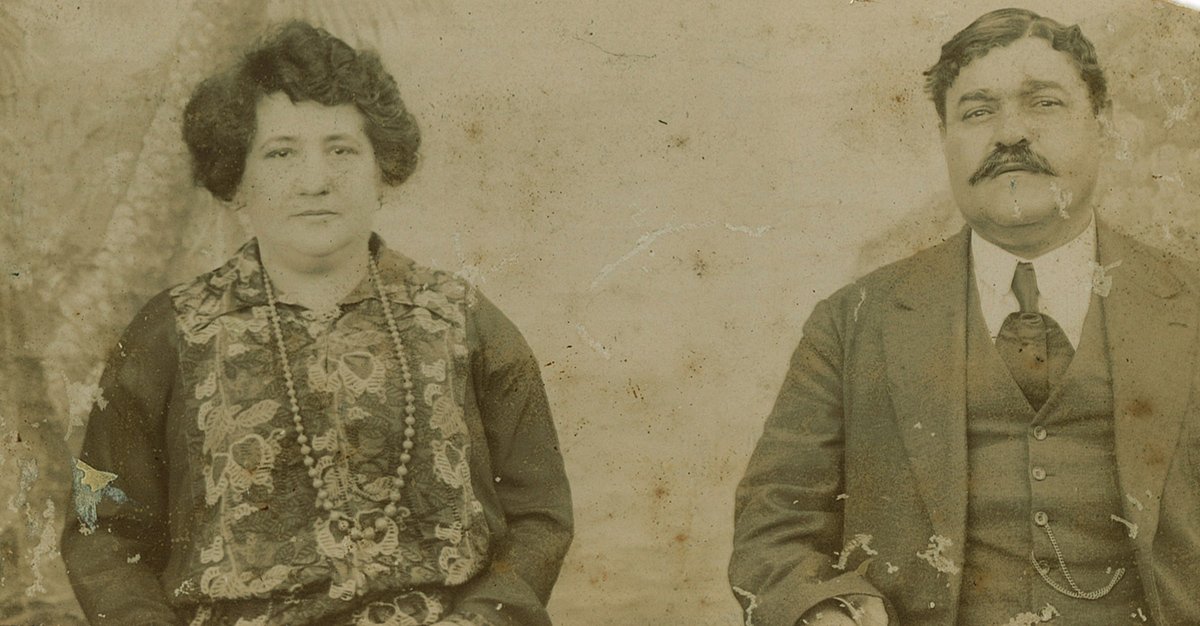
The donation increased the fortune of his son-in-law, business partner of his father-in-law as from 1907. In that year, Fernand Inard, Léonus Bénard and a number of other estate owners in Saint-Louis and Saint-Pierre bought the estate and factory of Pierrefonds from Germain Pradel. The factory had closed down in 1895. The ‘Société des Planteurs de Pierrefonds’ (Pierrefonds planters company) renovated the sugar factory, which once more became active during the sugar-cane harvest in 1907-1908. Dissolved in 1910, the Société des Planteurs de Pierrefonds was sold to Fernand Inard (318 shares), Jules Elysée (218 shares), Léonus Bénard (118 shares), Alfred Aubry (118 shares) and Mme Eugène Murat, maiden name Aubry (118 shares), who then created the ‘Société de Pierrefonds’. During the 1910s, Léonus Bénard progressively purchased his partners’ shares, becoming the sole owner of Pierrefonds.
Consequently, in 1917, with Maison Rouge and Pierrefonds, the Bénard spouses were owners of the two most magnificent properties in the south of the island, the origin of their fortune, which increased during the First World War thanks to the rise in the price of sugar. In 1922, following the division of the estates of the K/véguen family by the Mauritius-Reunion land company, Léonus Bénard considerably increased the land he owned in the south of the island. In Saint-Louis, he purchased the estate of Le Gol (including its annexes at Étang-Salé) and the estates of Bel Air and La Rivière/ La Chapelle (currently Les Cocos). In Saint-Pierre, he became owner of several large plots in La Ravine des Cabris and Les Casernes.
In this vast agro-industrial empire, covering several hectares between Étang-Salé and le Tampon and including three sugar factories, , Maison Rouge enjoys a specific status. The estate, considered to be the personal property of Fernande Bénard, never came under the common management of the estates in the south of the island belonging to her husband. This specific identity was confirmed by the creation of the company named Société civile de Maison Rouge (Maison Rouge real-estate company), set up on 9th June 1966.
Resident at Pierrefonds, Fernande Bénard entrusted Maison Rouge two managers, notably Adrien Grondin between 1926 and 1960. He managed the estate, dealing with the general accounts, workers’ pay, management of stocks, livestock and harvest of sugar cane, corn, peanuts and cassava, the main crops grown on the estate of Maison Rouge in the mid-20th century. It was also Maison Rouge that received the products (geranium essence and forest timber) from Bon Accueil, the name of the upper area of the estate, located in the hamlet of Makes. Photographs of the site, conserved by his son Alain, bear witness to the daily life and living conditions of the workers and other inhabitants of Maison Rouge during that 44-year period.
To the south of the farmyard, adjacent to it, on the side of the town of Saint-Louis, there were 10 timber houses sheltering the families of the agricultural workers: this was the village called ‘La Cour’, the original workers’ camp or compound of the estate. Behind the park, to the north of the house, on the site called La Barrière, the second group of houses sheltered the share-croppers working the land of Maison Rouge.
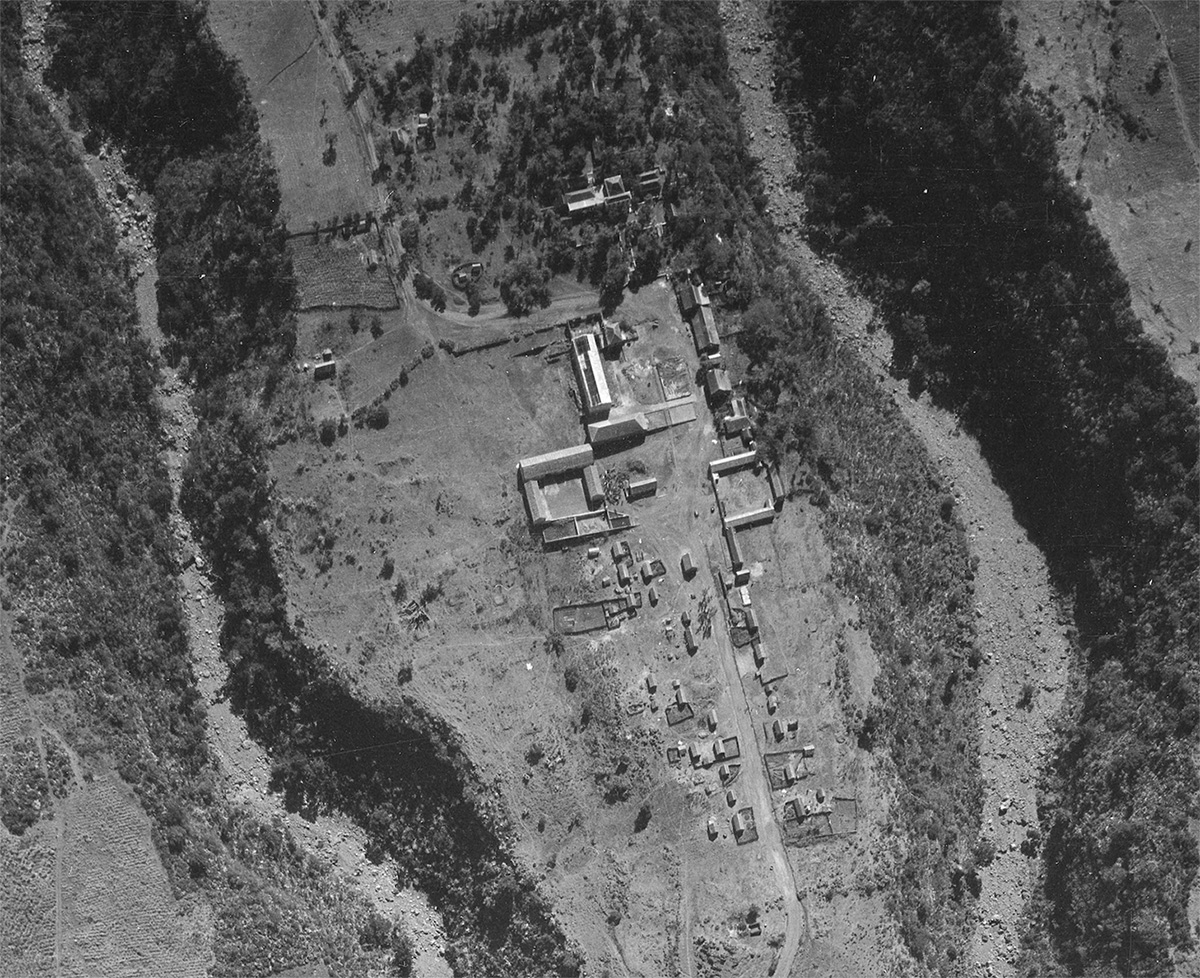
Below the mansion, baptised ‘Le Château’, several constructions surrounded the esplanade that formed the farmyard. In the east, timber storehouses with shingle roofs were lined up along the yard on the side of the Ravine du Mouchoir Gris. These included the cart workshop, a storehouse for fuel and a storeroom for cereals and other provisions produced on the estate. Today, the only outhouse still standing is the former accountant’s house. Adjoining these was the house of the Grondin family, burnt down during a fire in the early 1990s. Below this house, a U-shaped stone building was used as stables for the many mules that transported the sugarcane to the sugar factory of Le Gol. Alongside was a timber sheep pen. Facing the coffee-drying area, in the west of the yard was a large wooden building , used as a office. Adjoining this was a large masonry stable, with an impressive manure pit. Behind the stables, the vast gently-sloping esplanade was used in the 1930s-1940s as a football pitch.
Various houses were scattered around the estate, housing the caretakers of Maison Rouge: at the entrance to the estate under the large tamarind tree, still to be seen and not far from La Ravine du Gol; in the park, at the far end of the Chemin Jacques, not far from the Route Hubert-Delisle. Controlling the comings and goings of the estate was essential for maintaining order at Maison Rouge.
The mansion was not occupied all year round, but was the object of regular upkeep. Each visit by Fernande Bénard was preceded by the arrival of an army of servants, notably cooks, whose first task was to polish the copper cooking utensils. Two Indians where specifically entrusted with the task of painting the façade of the house.
The decorative garden to the front of the house was divided up into two parts: at the bottom, large benzoin trees created a plant screen. On the upper terrace at the foot of the house and the guesthouse, there were rosebushes planted in flowerbeds, which in the 1930s and 1940s was also planted with decorative Indian carnations and dahlias. The hedges of limeberry and calathea (shrubs with green and white leaves) lined the alleys, the flower beds and basins and were regularly pruned. In front of the dining room a large circular basin was used as a fish pond by the Bénard family.
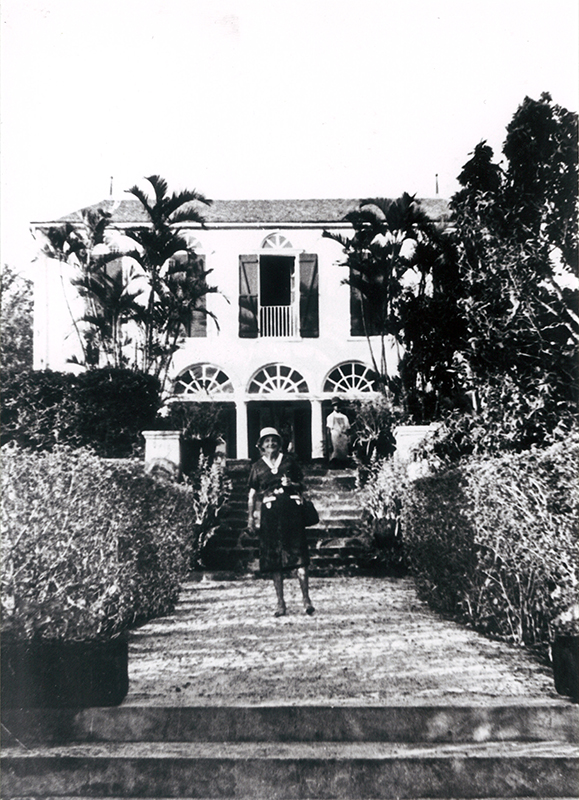
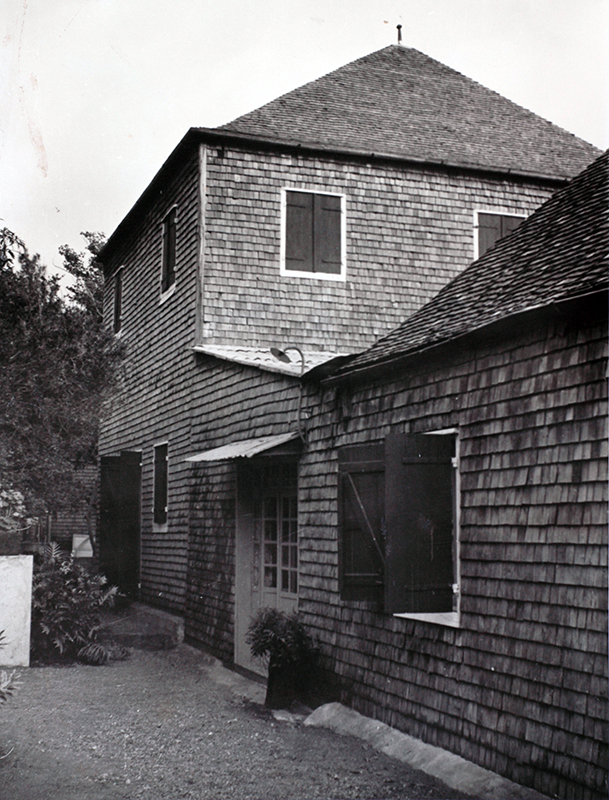
The veranda of the ground floor of the main house was reserved for guests. Two other deeper verandas, situated between the house and the dining room, and the one in front of the dining room, were the places where the Bénard family would really come and relax. At the back of the house and on the north side, several buildings, including a kitchen with a masonry oven, made up the outhouses. Behind the house was a large orchard planted mainly with lychees and mangoes. There were four wide alleyways, each also lined with limeberry, regularly pruned.
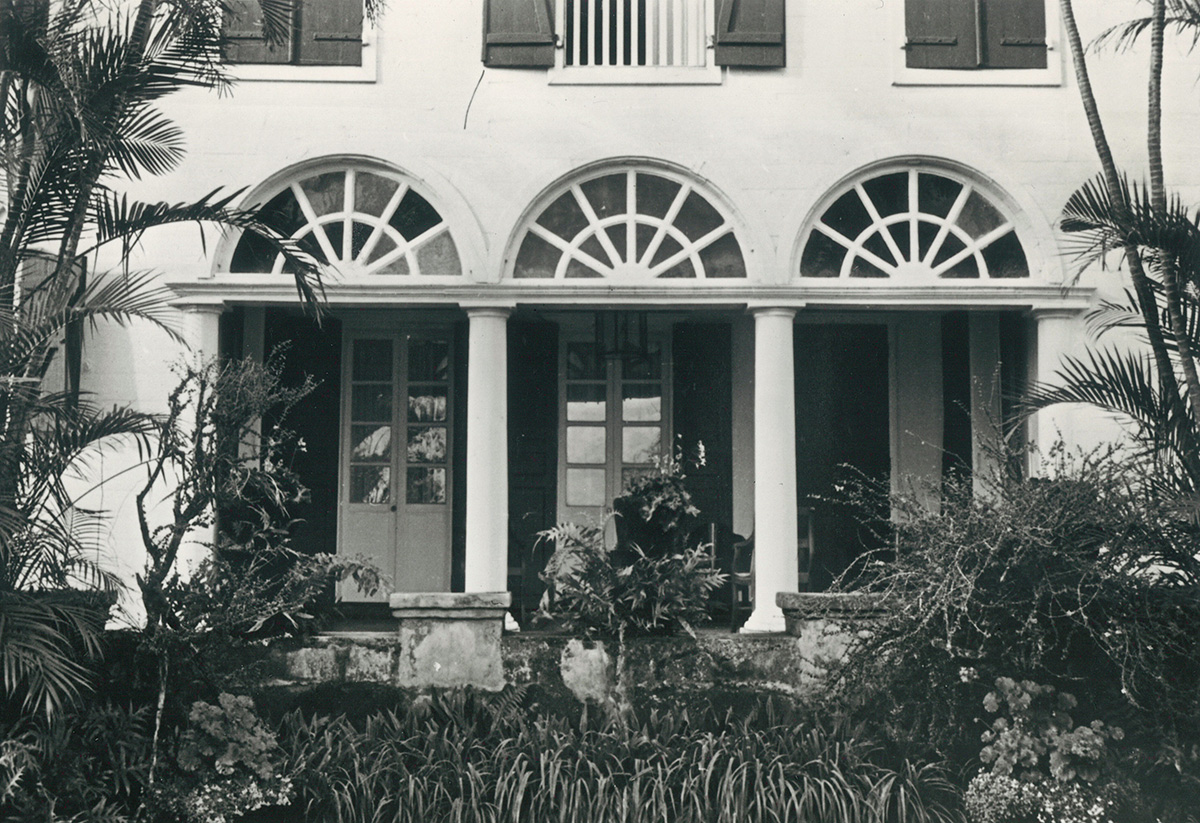
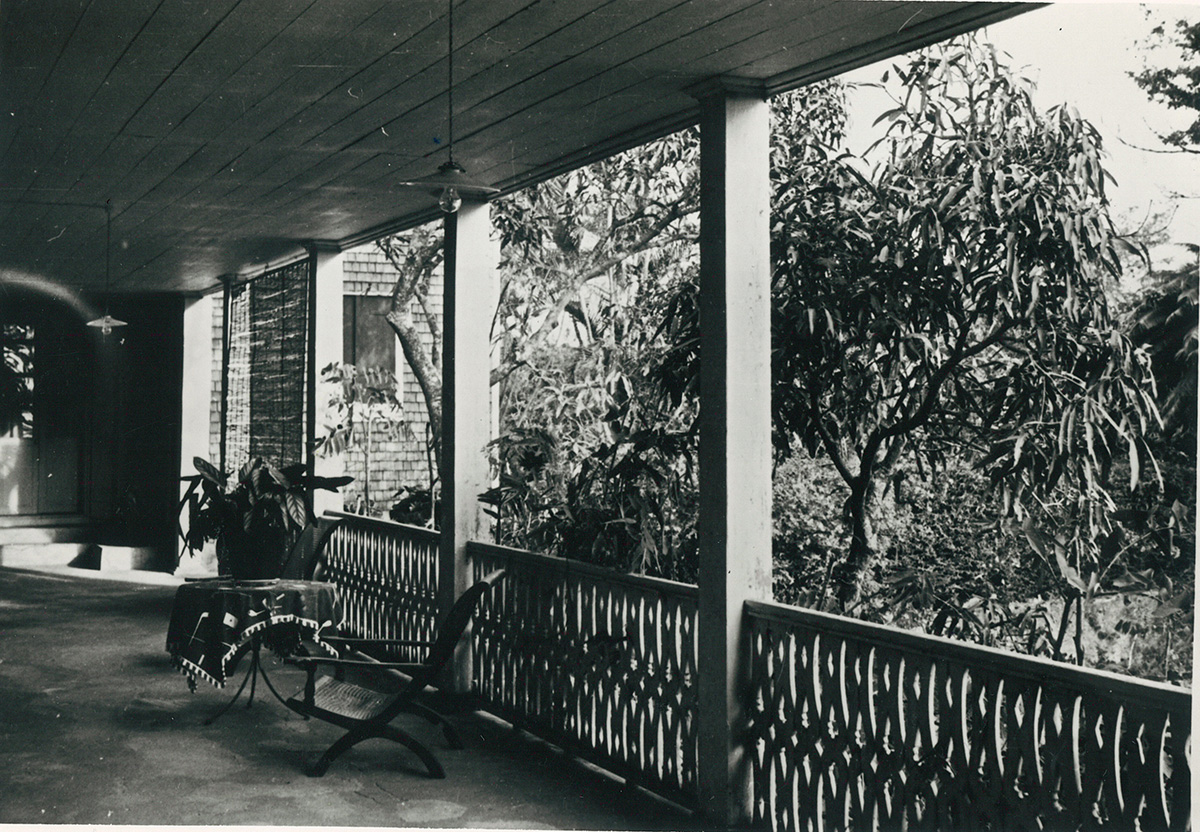
The death of Fernande Bénard in 1971 and the economic crisis facing sugar cane that occurred on the island in the 1970s marked the end of the prosperous period of Maison Rouge. In 1975, the real-estate company of Maison Rouge sold to the S.E.D.R.E. the lower, undeveloped, part of the estate, formerly used as pasture for the livestock (zebu and mules), with the aim of constructing social housing units, like those that already existed on the banks of the Ravine du Gol and the Ravine du Mouchoir Gris. However, in 1979 the project was abandoned and the Departmental Council of Reunion purchased these 40 hectares of savannah. Two years later, on 21st December 1981, the land was sold to the town council of Saint-Louis, and in order to preserve this historical heritage of Saint-Louis, this is part of the former estate of Maison Rouge was then listed as forest under the land occupation project. In fact, it is planned to replant the forest here on the basis of descriptions left by 18th-century travellers.
On 29th October 1982, the real-estate company of Maison Rouge sold the upper section of the estate, covering 348 hectares, to the S.A.F.E.R. (rural planning structure), which rented out the land to small-scale planters. Maison Rouge is now no longer a large sugar-cane estate. Not knowing what to do with the upper areas of the savannah, the coffee-dying area, the mansion and its grounds, the outhouses used for the servants and for agriculture, the vestiges of the cowsheds and stables, on 20th February and 2nd March 1987, the same company sold this unique architectural heritage to the town council of Saint-Louis, with the perspective of creating a museum of decorative arts.
1664: French East India Company
1722: Paul Sicre de Fontbrune
March 1725: French East India Company
Mars 1725: Antoine Desforges-Boucher
December 1725: Desforges-Boucher heirs
1767: Duclos
1773: Jacques Desforges-Boucher
1788: Heirs of Jacques Desforges-Boucher
1827: Richard Henri Nairac
1831: Nairac heirs
1832-1834: Lucie Nairac, widow of Murat
1867: Dominique Edevin Hoarau, father
1891: Dominique Edevin Hoarau, son
1896: Charles Martin
1897: Fernand Inard
1917: Fernande Adèle Inard, wife of Léonus Bénard
1966: Société civile Maison Rouge (real-estate company)